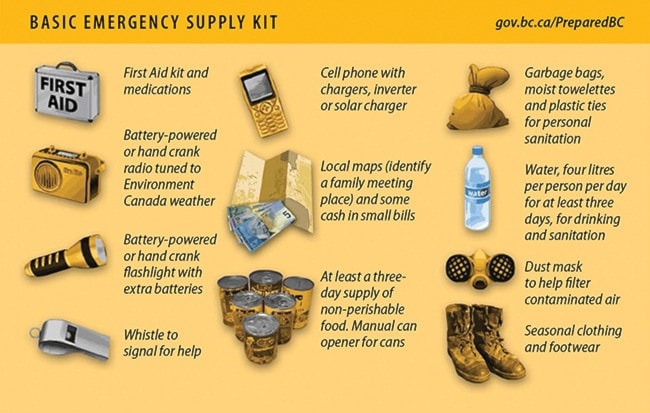While there were no reports of serious damage or injury as a result of the “moderate” earthquake that hit Vancouver Island last week, people have nonetheless been once again shaken into, “Am I prepared?” mode.
The 4.7 magnitude quake just north of Victoria Dec. 29 is another reminder for many that we’re still expecting the so-called “Big One,” and early in a new year is a great time to check your preparedness levels.
Information is the most important thing to be armed with in an emergency, according to PreparedBC, the provincial body that promotes emergency preparedness. Knowing the emergency risks and hazards in your area and how responders will act in such an event will make you better able to deal with the effects of an emergency if and when the time comes for you to do so.
Planning your own actions ahead of time is important. Make a household emergency plan which includes identifying at least two out-of-area contacts, meeting spots for family members to find each other, learning how to tun off utilities, and creating an emergency kit for your home and “Grab & Go” kits for each member of your household.
“When disaster hits, there won’t be time to collect emergency supplies,” PreparedBC warns.
Each “Grab & Go” kit should contain a copy of your emergency plan, a complete change of clothing including sturdy shoes and a warm jacket, any medications your family needs, water, a small first aid kit, a flashlight and extra batteries, along with some non-perishable food items like granola bars and a small amount of cash in small denominations. Ideally, it would also contain a crank-style or battery-operated handheld radio to receive updates on the situation and a whistle or other auditory signalling device. The kit should be made in a backpack or other bag that’s easy to transport – hence the name.
Your home emergency supply kit should contain all those items in greater amounts – at least three-days worth of water for each member of your household, for example, since you won’t be packing that kit around with you – along with sleeping bags, toiletries, purification tablets for water, basic tools like shovels, a hammer, pliers, wrenches, a small fuel-operated cooking device like a propane camping stove and non-perishable food to cook with it.
Home kits should be stored under a bed, in a closet close to the front door, the garage, or anywhere else that is cool, dry and easily accessible – even if the building has taken damage.
PreparedBC also recommends working together with your neighbours to increase community resilience.
“When disaster strikes, the most immediate help will come from those around you – your neighbours,” says the PreparedBC website. “Connecting and building relationships with them today will mean a better response and faster recovery.”
This relationship building will help identify neighbours that perhaps have special needs, but also those who have skills and resources that can help in the event of a serious earthquake or other disaster.
Visit the PreparedBC website (just Google “PreparedBC”) for more information.
